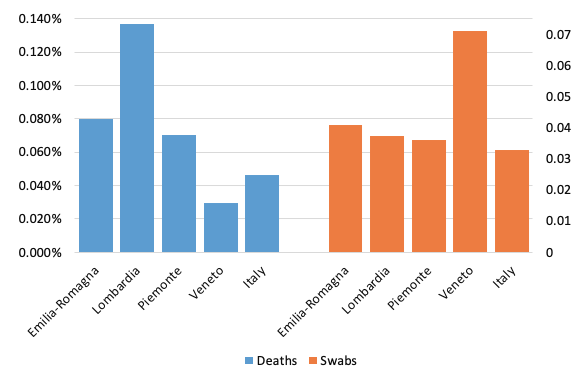It has become increasingly salient that public funded healthcare providers such as hospitals are sensitive to incentives. There is increasing evidence pointing out that competition between healthcare providers produces efficiency and improvements in quality (Gaynor and Propper 2010), despite the fact that in some countries it has not produced the outcomes initially expected (Gobillon and Milcent 2017). However, when healthcare providers compete with each other, coordination and information are left to market forces – via patients’ ability to choose the best provider, either public or private (Siciliani et al. 2017, Rechel et al. 2018, Levaggi and Levaggi 2020, Eurostat 2017). This raises concerns during a pandemic, when it is crucial that decision making is swift and information reaches all healthcare providers.
Covid-19 as an experiment
The management of Covid-19 in Europe has become a test for how agile the systems of managed competition are in the event of a health emergency, and more specifically, in delivering the decision that benefits patients in swift manner. In a recent article (Costa-Font et al. 2020) we suggest that organisational models that lack an integrated authority might not be able to manage coordination, which results in delayed responses and higher fatalities, when timely health service reaction is key (Mak et al. 2020). This is especially true for coordination among services such as primary care, hospital services, and home care.
When authority is integrated, regulators (which are used to manage competition) are better equipped to purchase personal protective equipment (PPE), manage the supply of hospital beds, and coordinate with other social services (e.g. transfers in and out of nursing homes). Networks with an integrated authority can reduce the risks of local shortages of PPE and are able to identify and react to infected hospitals (for example, by devoting some facilities to the emergency, while leaving other hospitals free to carry on with normal hospital treatments).
Evidence from Italy
Possibly one of the most illustrative case studies of the effects of governance on the management of the pandemic is Italy, a country severely affected by the Covid-19 pandemic. At the time of writing, the number of official contagions has raised to about 275,000 cases and 35,550 deaths. Since 1992, healthcare has been regionally decentralised (i.e. different regions can make decisions around the organisation of inpatient and primary care). Particularly illustrative is the evidence from the three regions most severely hit at the beginning of the pandemic (Emilia Romagna, Veneto, and Lombardy), which have chosen a different model of managed competition.
Emilia Romagna adopted a model based on healthcare integration whereby public hospitals are situated within integrated networks. The intensity of use of private providers is determined by the regional authority, which sets quality goals. About half of all beds are under the control of the regional health service. In contrast, Veneto has implemented a model of limited managed competition in the form of an internal market. Patients can choose among public and private providers with the presence of an integrated authority which controls the management of public hospitals. About two thirds of beds are under the control of the regional health service. This has limited shortages and allowed the closure of hospitals when needed.
Lombardy, unlike other regions, has adopted a disintegrated managed competition model based on an unambiguous separation between purchasing and providing functions. Public hospitals have been transformed into autonomous organisations to compete with private providers. This means that no single bed is under the control of the regional health authority, which merely defines the general goals and controls their implementation. However, during a pandemic, regional authorities face coordination failures and unnecessary delays in the information sharing between hospitals in the networks and the regional authority.
Lombardy was more severely hit by Covid-19 than any other Italian regions. Some recent evidence (Cereda et al. 2020) shows that the virus was present as early as mid-January. Further, the genetic sequence of the virus that spread in Codogno is different from the one in Bergamo (i.e. the region was hit from several fronts at the same time). However, Covid-related hospital fatalities in Lombardy have been about twice the sum of those in Emilian Romagna and Veneto. In some cases, the integration between hospitals and other services has been problematic, especially with regard to nursing homes (Berloto 2020), emergency care (Garrafa et al. 2020), and family doctors. Some of these problems may have been exacerbated by the governance model. Figure 1 shows the number of deaths and swabs that were performed in the four ‘most-hit regions’ in Italy in March and April 2020.1 Lombardy appears to be the region with the largest death rate per inhabitant. This result is even most striking when observing that the share of the elderly (the group most hit by the virus) is largely comparable across the three regions. Although the region was more severely hit (and was likely to be the epicentre of the pandemic), this clear difference calls for more research into the matter.
Figure 1 Deaths (left) and swabs (right) per inhabitant, selected regions
What type of managed competition works best?
Decentralised managed competition does not seem to be the most effective model to manage a pandemic event. However, this system seems to be quite effective in improving quality and reducing heterogeneity among providers during normal times (Levaggi et al. 2020). If pandemics are a test of which models of managed competition we should adopt, an integrated model seems to provide a swifter reaction by minimising coordination efforts and information costs. However, in view of the trade-off that seems to emerge, more research should be devoted to combining the benefits of integration and decentralised managed competition in a new governance setting for the provision of public healthcare.
References
Berloto, S, E Notarnicola, E Perobelli and A Rotolo (2020), “Italy and the COVID-19 Long-Term Care Situation”.
Cereda, D, M Tirani, F Rovida, V Demicheli, M Ajelli, P Poletti, F Trentini, G Guzzetta, V Marziano, A Barone, M Magoni, S Deandrea, G Diurno, M Lombardo, M Faccini, A Pan, R Bruno, E Pariani, G Grasselli, A Piatti, M Gramegna, F Baldanti, A Melegaro and S Merler (2020), “The Early Phase of the COVID-19 Outbreak in Lombardy, Italy”.
Costa-Font, J, R Levaggi and G Turati (2020), “Resilient Managed Competition during Pandemics: Lessons from the Italian Experience during COVID-19”, Health Economics, Policy and Law e-pub ahea: 1–16.
Eurostat (2017), “Healthcare Resource Statistics - Beds”, Brussel, Belgium.
Garrafa, E, R Levaggi, R Miniaci and C Paolillo (2020), “When Fear Backfires: Emergency Department Accesses during the Covid-19 Pandemic”, Mimeo.
Gaynor, M and C Propper (2010), "Healthcare competition saves lives", VoxEU.org, 23 August.
Gobillon, L and C Milcent (2017), "The effects of decentralisation and competition on hospital management and performance in France", VoxEU.org, 21 July.
Levaggi, L and R Levaggi (2020), “Is There Scope for Mixed Markets in the Provision of Hospital Care?”, Social Science and Medicine 247.
Levaggi, R, G Martini and D Spinelli (2020), “Do Patients Elect Reference Hospitals? Evidence from Three Italian Regional Health Systems”, Mimeo.
Mak, T K, J C W Lim, P Thanaphollert, G N Mahlangu, E Cooke and M M Lumpkin (2020), “Global Regulatory Agility during Covid-19 and Other Health Emergencies”, The BMJ 369.
Rechel, B, A Duran and R Saltman (2018), "What Is the Experience of Decentralized Hospital Governance in Europe?", E Richardson and A Sagan (eds), policy brief, World Health Organization.
Siciliani, L, M Chalkley and H Gravelle (2017), “Policies towards Hospital and GP Competition in Five European Countries”, Health Policy 121 (2): 103–110.
Siciliani, L and O R Straume (2019), “Competition and Equity in Health Care Markets”, Journal of Health Economics 64: 1–14.
Endnotes
1 For a more complete analaysis, see Costa-Font et al. (2020).







